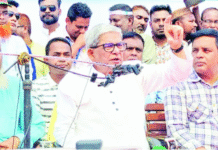The World Bank feels Bangladesh is well on its way to achieve the United Nations Millennium Development Goal (MDG) in poverty alleviation within this year.

In a report, the World Bank said that 57 percent of Bangladesh’s population was below the poverty level in 1990.
The target under the Millenium Development Goal was to bring it down to 29.5 percent within 2015.
However, analysing statistics of the past decade, the World Bank has concluded that Bangladesh will achieve the target two years ahead of the schedule, the World Bank’s report titled ‘Bangladesh Poverty Assessment’ said.
It was released on Thursday noon.
The report, based on purchasing ability, said that incidence of poverty came down gradually during the last decade from 63 million poor people in 2000 to 47 million in 2010.
“Bangladesh is on track to achieve these two Millenium Development Goals.”
Based on the analysis, the report predicted that by 2015, the poverty rate in Bangladesh will be 2 percent lower than the target set originally – around 26 percent – even if somewhat affected by a low growth of 3.8 percent.
According to Bangladesh Bureau of Statistics (BBS) 2010 household survey, 31.5 percent of the total population lives below the poverty line – including 17.6 percent who are said to be ‘extremely poor’.
The World Bank report said in 2000, 48.9 percent of total population was living under poverty line including the 34.3 percent ‘extremely poor’.
Considering this, Bangladesh reduced poverty by 1.74 percent since 2000 each year on an average.
The global lender identified two factors leading to this success – wage hike and reduction in population growth rate which led to a decreased pressure on resources and incomes.
“Earlier a family used to depend on one earning member. Now, many have multiple earning members,” the report said.
Every year on average during 2000-2010, 1.8 million people have been pulled out of extreme poverty by improving their living standards.
And 1.6 million have been dragged out from below poverty line to above it every year.
The report said that income in non-institutional sectors like agriculture, and small transport like rickshaw-pulling have gained by 10 percent each year.
It said only 10 percent of the net poor population were covered by electric connections in 2000.
Ten years later, the percentage increased to 28.5 percent.
In 2000, no poor people used mobile phones, but in 2010, 36.3 percent were in possession of one.
Former Finance Advisor to a caretaker government, AB Mirza Azizul Islam, told bdnews24.com that it was mainly due to a steady GDP growth that the UN goal could be achieved two years ahead of schedule.
“For a few years now, we have a growth of average 6 percent or more. This has contributed to poverty alleviation .”
World Bank Dhaka office Social Protection team Senior Economist Iffath Sharif told bdnews24.com that poverty was coming down consistently during the last three decades in Bangladesh. “This trend was on even despite the global economic crisis.”
“After the unnatural rise in food prices worldwide during 2007-08, many were fearing that the number of poor would rise in Bangladesh. But it did not happen. Poverty has been coming down as before.”
Another official of World Bank Dhaka office, a Research group Senior Economist Dan M Zoelifi said he thought that the government’s social security measuress held the key to poverty reduction.
“Though about 40 percent of the poor people are still outside its coverage, this has helped a lot.”
He said success in poverty alleviation will be more pronounced if the entire poor population could be brought under the social security net.
Meanwhile, he affirmed that Bangladesh Bureau of Statistics was a credible source of information. “Their statistics are of global standards. There is no question of their credibility.”
Iffath Sharif and Dan Zoelifi helped prepare the World Bank report.
Source: Bd news24









